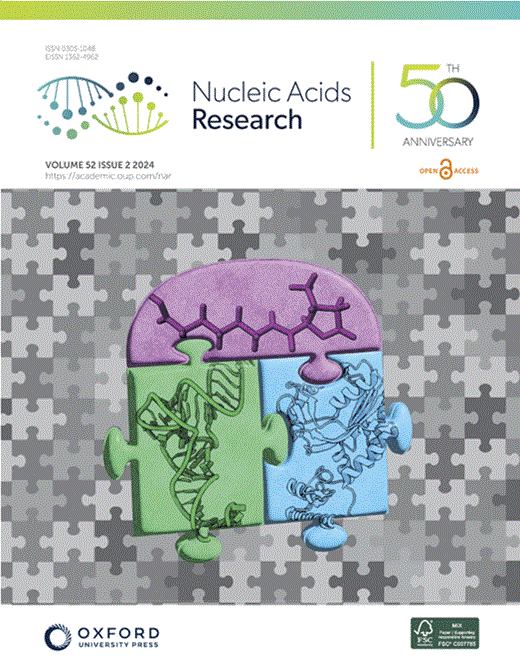染色质相关α-卫星RNA通过在有丝分裂细胞周期中重建saa来维持染色体的稳定性
IF 16.6
2区 生物学
Q1 BIOCHEMISTRY & MOLECULAR BIOLOGY
引用次数: 0
摘要
α-卫星是最大的串联重复序列,位于所有人类染色体着丝粒上。非编码α-卫星rna已经在多种细胞类型中被观察到,并且在维持基因组稳定性方面发挥着至关重要的作用。在这项研究中,我们证明了α-卫星rna是动态表达的,是由极光激酶调控的异质转录本,在整个有丝分裂细胞周期中与着丝粒染色质密切相关。我们发现支架附着因子A (SAF-A)是一种以前未被表征的α-卫星RNA结合蛋白。α-卫星RNA或SAF-A的缺失都会导致染色体错分离,这表明它们的协同作用对于在有丝分裂细胞周期中保持基因组完整性至关重要。我们的研究结果表明,在有丝分裂期间,SAF-A被排除在全基因组的染色质中,并且在有丝分裂退出时需要α-卫星rna来招募SAF-A。α-卫星rna和SAF-A在有丝分裂过程中保护人类基因组免受染色体不稳定的影响是必不可少的。此外,α-卫星rna和SAF-A有助于核层的重组。我们的研究结果为α-卫星rna的特征、调控和功能作用提供了新的见解,并提出了有丝分裂过程中SAF-A核支架的拆除和重组模型。本文章由计算机程序翻译,如有差异,请以英文原文为准。
Chromatin-associated α-satellite RNA maintains chromosome stability by reestablishing SAF-A in the mitotic cell cycle
α-Satellite is the largest class of tandem repeats and is located on all human chromosome centromeres. Non-coding α-satellite RNAs have been observed in various cell types and are known to play crucial roles in maintaining genome stability. In this study, we demonstrated that α-satellite RNAs are dynamically expressed, heterogeneous transcripts that are regulated by Aurora kinases and closely associated with centromere chromatin throughout the mitotic cell cycle. We identified scaffold attachment factor A (SAF-A) as a previously uncharacterized α-satellite RNA binding protein. Depletion of either α-satellite RNA or SAF-A resulted in chromosome missegregation, revealing that their concerted action is essential for preserving genome integrity during the mitotic cell cycle. Our result demonstrated that SAF-A is excluded from the chromatin genome-wide during mitosis, and α-satellite RNAs are required for the recruitment of SAF-A upon mitotic exit. Both α-satellite RNAs and SAF-A are essential in safeguarding the human genome against chromosomal instability during mitosis. Moreover, α-satellite RNAs and SAF-A aid in the reassembly of the nuclear lamina. Our results provide novel insights into the features, regulations, and functional roles of α-satellite RNAs and propose a model for the dismantling and reformation of the SAF-A nuclear scaffold during mitosis.
求助全文
通过发布文献求助,成功后即可免费获取论文全文。
去求助
来源期刊

Nucleic Acids Research
生物-生化与分子生物学
CiteScore
27.10
自引率
4.70%
发文量
1057
审稿时长
2 months
期刊介绍:
Nucleic Acids Research (NAR) is a scientific journal that publishes research on various aspects of nucleic acids and proteins involved in nucleic acid metabolism and interactions. It covers areas such as chemistry and synthetic biology, computational biology, gene regulation, chromatin and epigenetics, genome integrity, repair and replication, genomics, molecular biology, nucleic acid enzymes, RNA, and structural biology. The journal also includes a Survey and Summary section for brief reviews. Additionally, each year, the first issue is dedicated to biological databases, and an issue in July focuses on web-based software resources for the biological community. Nucleic Acids Research is indexed by several services including Abstracts on Hygiene and Communicable Diseases, Animal Breeding Abstracts, Agricultural Engineering Abstracts, Agbiotech News and Information, BIOSIS Previews, CAB Abstracts, and EMBASE.
 求助内容:
求助内容: 应助结果提醒方式:
应助结果提醒方式:


